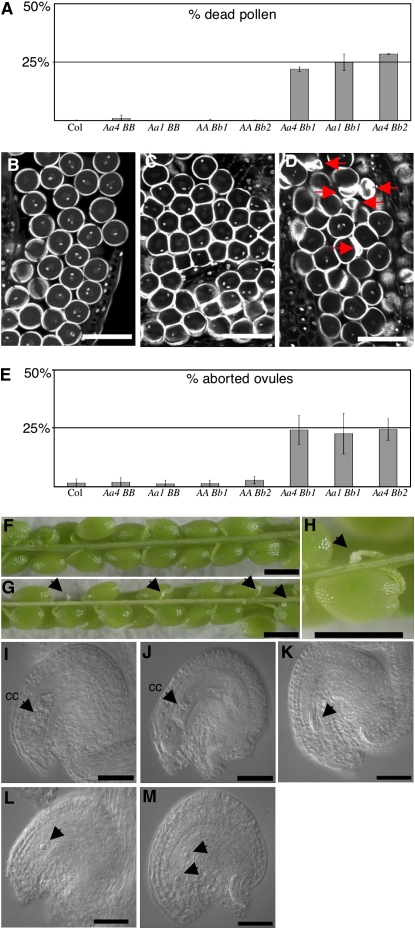Figure 5.
rpt5a rpt5b Mutants Are Male and Female Gametophytic Lethal.
(A) Scoring of pollen lethality by Alexander staining of mature anthers followed by counting of dead pollen. B, b1, and b2 stand for wild-type RPT5b and mutant rpt5b-1 and rpt5b-2 alleles, respectively. All crosses are set in Col background. Values are shown as means on six independent plants (±sd).
(B) to (D) Optical sections through propidium iodide–stained anthers show mature pollen nuclei of Aa4BB (B), AABb1 (C), and Aa4Bb1 (D) plants. In single heterozygous mutants, pollen develop until PMII (B, C), while in double heterozygous mutants, some pollen grains degenerate, as indicated by arrows (D). Because of section planes, only one of the two sperm cell nuclei can be seen in some pollen grains.
(E) Scoring of ovule lethality in mature siliques using the same plants as in (A). Percentage of aborted ovules per siliques is represented. Values are shown as means on 10 independent siliques (±sd).
(F) to (H) All seeds develop in Col siliques (F), while Aa4Bb1 display 25% white structures that are aborted ovules ([G] and [H], designated by arrows).
(I) DIC image of a mature wild-type ovule at the time of fertilization. It features an enlarged central cell nucleus (cc).
(J) to (M) DIC image of mature ovule in Aa4Bb1 plants. At the time of fertilization, in siliques, 75% of the ovules present the feature of well-developed embryo sacs, such as an enlarged central cell nucleus (cc) and a large vacuole (J). Other embryo sacs display an altered structure and are blocked at one- (L) or two-nuclei stages (M); arrows indicate the nuclei. In a few cases, the whole embryo sac has degenerated ([K], arrow).
Bars = 40 μm in (B) to (D), 100 μm in (F) to (H), and 25 μm in (I) to (M).

